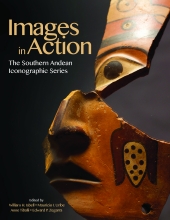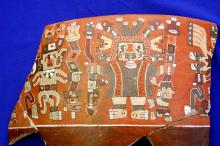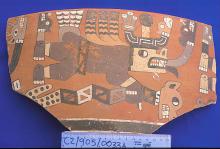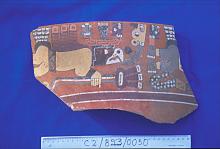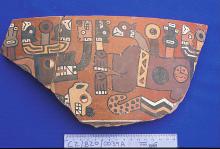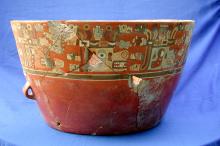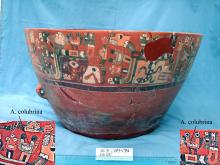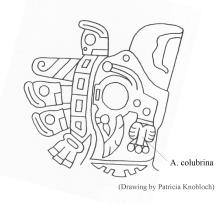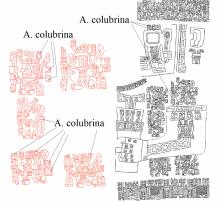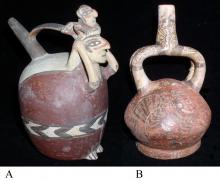Visual database
Conchopata 1942/1999 Staff God and Profile Attendants. First discovered by Julio C. Tello in 1942, Menzel (1964, 1977) restudied Tello's collection of deliberately smashed giant urns, constructing its inventory of images from fragments much less complete than this large sherd discovered in 1999. Menzel named this variant of Profile Attendant Angel A. She argued that this Staff God and its Profile Attendants represented the initial introduction of Tiahuanaco imagery into Ayacucho, initiating Middle Horizon Epoch 1a and inspiring cultural changes that precipitated the Wari polity and its capital city. However, it is now clear that this style of Staff God and Profile Attendant is later than the SAIS iconography discussed above that decorates smashed jars but that SAIS imagery is no older than Middle Horizon Epoch 1B. Furthermore, SAIS imagery appeared after the development of the Nasca-Wari, Chakipampa ceramic style; after the first ceremonial smashes of giant jars; and after the formation of Wari as an expansive political system governed from an urbanized heartland.
Horizontal winged Profile Attendants, apparently flying, that have feline or human faces were named Angel C by Menzel (1964, 1977). They are part of the inventory of SAIS imagery associated with the 1942/1999 Conchopata offerings.
Winged horizontal Profile Attendants with avian faces were also classified as Angel C by Menzel (1964, 1977) and belong with the 1942/1999 Conchopata offerings.
Horizontal Profile Attendants with feline or human faces, lacking wings but with distinct projections from the back, were named Angel D by Menzel (1964, 1977). They also belong with the imagery of the 1942/1999 Conchopata offerings.
This giant Conchopata urn is decorated with disembodied mythical profile heads that probably derived from Profile Attendants. This icon is unique to the Conchopata/Huari sphere of late SAIS imagery. Furthermore, this urn has no Anadenanthera colubrina symbols.
This giant urn from Conchopata is decorated with variations of the disembodied mythical profile head, including feline/human-faced and avian-faced heads. Two Anadenanthera colubrina symbols appear in the crown in each image, one in the top and one in the back. It seems significant that this urn, like some other religious art from Conchopata, has numerous Anadenanthera colubrina symbols, while some objects (15.48) have few or none at all. Religion in the Huari sphere seems (as at Tiahuanaco) to have included two types of experiences, one more based on hallucinogenic trance characteristic of shamanism and the other more sober and doctrinal in nature.
The eye of the avian-faced Profile Attendant on Tiahuanaco's Gate of the Sun has an Anadenanthera colubrina symbol attached. It is the only convincing Anadenanthera colubrina icon on the Gate of the Sun. Drawing by Patricia Knobloch.
These details from the left upper portion of the Ponce monolith are replete with Anadenanthera colubrina symbols, as is the entire statue and many other Tiahuanaco religious sculptures. It seems likely that relative abundance of Anadenanthera colubrina imagery in Tiahuanaco (and Huari) religious art relates to the popularity of hallucinogen-induced, shamanic types of religious experiences among the patrons of that art. Scarcity of Anadenanthera colubrina imagery in religious art probably relates to preferences for more sober and doctrinal kinds of religious experiences. To the degree that this is true, it seems that Tiahuanaco (and Huari) enjoyed two distinct modes of religious experience that were probably in conflict and negotiation, at least some of the time. Drawing by Amy Oakland, enlarged figures in red redrawn by William H. Isbell.
Anadenanthera colubrina symbols appear abundantly in the imagery on the Late SAIS Tiwanaku Phase 5 Taquiri Cube. Phase 5 in the Agüero et al. seriation (2003) also includes the Gate of the Sun-with its single location for A. colubrina and the Llojeta Block, apparently lacking the symbol (illustration based on Ryden 1947:357, Figure 147).
Left, an example of a Wari hybrid vessel from the Cañete Valley, courtesy of The Field Museum, Cat. No. 170243, photograph by Donna Nash. Right, an example of a Wari hybrid vessel (Wari Norteño) from the San Jose site of the Lambayeque Valley (Editor's note: it seems likely that this vessel came from the site currently known as San Jose de Móro, which is actually located in the Jequetepeque Valley). Courtesy of The Field Museum, Cat. No. 171668, photograph by Donna Nash. Such stylistic blending is widely apparent on Inka aribola in regions the Inka empire controlled, but earlier Wari hybrids and stylistic variations are considered a material correlate of interpolity exchange and interaction rather than political control.
